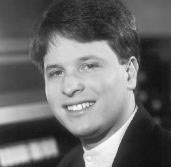PAUL JACOBS
St. James Cathedral, 804 Ninth, 382-4874, suggested donation $15 ($25 for both evenings) 7:45 p.m. Fri., June 14-Sat., June 15
THOUGH HIS CAREER was divided between the church and the conservatory, Olivier Messiaen was anything but a cloistered academic. Rather than simply label himself a composer, he suggested more evocative terms: “I’m an ornithologist and a rhythmician.”
Above all, though, Messiaen was a Catholic, pouring out his joyous faith in vast musical canvases blazing with color. To mark the 10th anniversary of his death, St. James Cathedral will present Messiaen’s complete organ works (eight multimovement pieces plus some smaller compositions) in two recitals. Both programs, running about four and a half hours each (including two intermissions), will be played by organist Paul Jacobs, who’s also performed the marathon session in cities including Chicago, San Francisco, and Washington, D.C.
Messiaen’s music uses the organ’s shadings and textures to rich, full effect, veering from motionless meditation to jubilant chaos, with harmonies that range from opulent prettiness to paint-peeling dissonance. It’s also filled with birdsong—literal transcriptions of calls that Messiaen gathered in his travels around the world, with each specific bird meticulously named in the score. Fascinated by rhythm, he brought the sound of ancient Greece and talas from traditional Indian music into his work and experimented with methods for organizing musical time (he’s credited as the first composer to apply Schoenberg’s 12-tone system to the duration and loudness of notes as well as to their pitch).
His early Diptyque (to be heard Friday), written in 1930 when Messiaen was just 22, is typical of his catalog. The movement’s subtitles, “Earthly Life” and “Paradise,” show that his relative youth didn’t keep him from tackling grand subjects. The opaque swirls of the first section sound a bit like Wagner and Scriabin taking mushrooms together; the second passage features one of the enraptured, static movements he often favored. The Pentecost Mass (also Friday), from 1950, is based on his eloquent improvisations. During his long career as organist for the Church of La Trinit頩n Paris, he became known as one of the masters of the craft.
For 1969’s Meditations on the Mystery of the Holy Trinity (Saturday), Messiaen, ever the explorer, created a musical-verbal language by assigning notes to letters and verbs, spelling out in sound quotations from St. Thomas Aquinas. Awe-inspiringly complex in many ways, his music can also be powerfully direct, even naive, in pictorial expression. Meditation No. 4 ends with an affirmative passage titled “Je suis!” (“I am!”): riotous fistfuls of notes, captured in the phrase’s two-syllable rhythm, played at maximum volume. Soon after, in No. 5, comes a serene chorale labeled “God Is Love” (it sounds less hokey in French). After all those roaring tone clusters, the pure major and minor chords of this hymn sound pleasurable to the point of outright eroticism. For Messiaen, too, harmony and visual color were strongly linked—he describes one passage in this fifth Meditation as evoking “golden yellow, blue of Chartres [i.e., the brilliant blue of the stained-glass windows in Chartres Cathedral], violet purple, green and red, orange tint, violet amethyst, mauve, and pearl grey.”
Taking his own path, Messiaen remained nobly above the controversies (tonal vs. atonal, Stravinsky vs. Schoenberg) that polarized so many mid-20th-century composers. This led some to underestimate him; during this period, one’s importance (especially in France) was determined largely by how many younger composers could be persuaded to copy your style. But Messiaen’s influence on subsequent generations might be strongest in the area of musical syntax—he was a postmodern collagist before his time. His student Pierre Boulez called him “not a composer, but a juxtaposer.” In Messiaen’s recipes, the eclectic flavors—the birdcalls and ragas and sonic explosions—remain distinct, set off from one another for maximum contrast.
But this collage technique, too, stems from his spiritual beliefs. A piece by Messiaen is not a dramatic or emotional journey from point A to point B, like, say, a symphony by Brahms. Messiaen’s disparate musical events don’t lead, narrative-style, from one to the next, carrying you forward in time. Rather, he was the master of the musical jump cut. His gestures each exist on their own, and this lack of goal-directed motion becomes a perfect metaphor for timelessness and Messiaen’s consuming passion—otherworldly religious contemplation.







